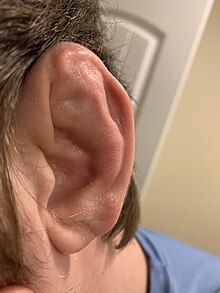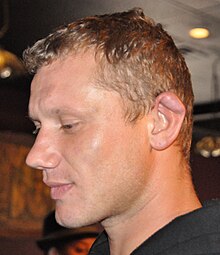Cauliflower ear
| Cauliflower ear | |
|---|---|
 | |
| Cauliflower ear | |
| Specialty | Otorhinolaryngology |
Cauliflower ear is an irreversible condition that occurs when the external portion of the ear is hit and develops a blood clot or other collection of fluid under the perichondrium. This separates the cartilage from the overlying perichondrium that supplies its nutrients, causing it to die and resulting in the formation of fibrous tissue in the overlying skin. As a result, the outer ear becomes permanently swollen and deformed, resembling a cauliflower, hence the name.
The condition is common in
Presentation
People presenting with possible auricular hematoma often have additional injuries (for example, head/neck lacerations) due to the frequently traumatic causes of auricular hematoma. The ear itself is often tense, fluctuant, and tender with throbbing pain. However, because of potentially more remarkable injuries often associated with auricular hematoma, auricular hematoma can easily be overlooked without directed attention.[1]
Diagnosis

To assist with settling on the best form of treatment for cauliflower ear, Yotsuyanagi et al created a classification system for deciding when surgery is needed and as a guide as to what the best approach would be.[3]
| Type 1: Minimal deformity with no or slight changes to the outline of the ear | Type 2: Substantial deformity of the outline of the ear | ||
|---|---|---|---|
| Type 1A | Deformity is restricted to the concha of the ear | Type 2A | The structural integrity of the ear is intact |
| Type 1B | Deformity that extends from the antihelix to the helix of the ear | Type 2B | Poor structural integrity of the ear |
| Type 1C | Deformity that extends throughout the outer ear | ||
Causes
The most common cause of cauliflower ear is blunt trauma to the ear leading to a hematoma which, if left untreated, eventually heals to give the distinct appearance of cauliflower ear. Most commonly coming from participating in grappling and combat sports such as Brazilian jiu-jitsu and mixed martial arts. The structure of the ear is supported by a cartilaginous scaffold consisting of the following distinct components: the helix, antihelix, concha, tragus, and antitragus.[1] The skin that covers this cartilage is extremely thin with virtually no subcutaneous fat while also strongly attached to the perichondrium, which is richly vascularized to supply the avascular cartilage.[1]
Cauliflower ear can also present in the setting of nontraumatic inflammatory injury of auricular connective tissue such as in
Mechanism
The components of the ear involved in cauliflower ear are the outer skin, the perichondrium, and the cartilage.[2] The outer ear skin is tightly adherent to the perichondrium because there is almost no subcutaneous fat on the anterior of the ear.[2] This leaves the perichondrium relatively exposed to damage from direct trauma and shear forces, created by a force pushing across the ear like a punch, and increasing the risk of hematoma formation.[2] In an auricular hematoma, blood accumulates between the perichondrium and cartilage. The hematoma mechanically obstructs blood flow from the perichondrium to the avascular cartilage.[1] This lack of perfusion puts the cartilage at risk for becoming necrotic and/or infected.[1] If left untreated, disorganized fibrosis and cartilage formation will occur around the aforementioned cartilaginous components.[1]
Consequently, the concave pinna fills with disorganized connective tissue.[1] The cartilage then deforms and kinks, resulting in the distinctive appearance somewhat resembling a cauliflower.[1] Rapid evacuation of the hematoma restores close contact between the cartilage and perichondrium, thereby reducing the likelihood of deformity by minimizing the ischemia that would otherwise result from a remaining hematoma.[1]
Auricular hematoma most often occurs in the potential space between the helix and the
Preventions

Headgear called a "
Treatment

There are many types of treatment for the perichondral hematoma that can lead to cauliflower ear, but the current body of research is unable to identify a single best treatment or protocol.[6] There is definitive evidence that the drainage of this hematoma is better for the prevention of cauliflower deformity when compared to conservative treatment, but the use of bandages and/or splinting after drainage requires more research.[6]
Because an acute
History

The presentation of cauliflower ear was recorded in ancient Greece.[13]
In 19th-century Hong Kong opium dens, opium users would develop cauliflower ear from long periods sleeping on hard wooden pillows.[14]
References
- ^ PMID 28127072.
- ^ S2CID 260133952.
- ^ PMID 12372365.
- ^ PMID 17113965.
- ^ Williams, Preston (2008-03-06). "For Wrestlers a Swelled Sense of Pride". The Washington Post. p. 14. Archived from the original on 2012-11-10. Retrieved 2008-04-02.
- ^ PMID 15106240.
- ^ Inna Leybell (May 10, 2018). "Auricular Hematoma Drainage". Medscape. Archived from the original on September 6, 2011. Retrieved October 26, 2011.
- PMID 22695406.
- PMID 16558175.
- ^ "Cauliflower ear – How to avoid and treat". 2019-01-28. Archived from the original on 2019-01-30. Retrieved 2019-01-29.
- ^ "Cauliflower Ear Article". Nationwide Children's Hospital: Sports Med Articles. Archived from the original on 6 August 2012. Retrieved 23 December 2011.
- ISBN 978-1-935618-63-8.
- ISBN 9780500202494.)
{{cite book}}: CS1 maint: location missing publisher (link - PMID 9771361.
External links
- Cauliflower ear, Cleveland Clinic
- Cauliflower ear, medical illustration, eMedicineHealth
